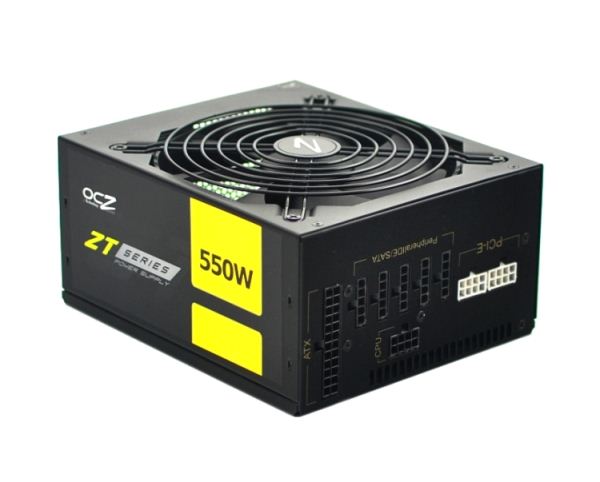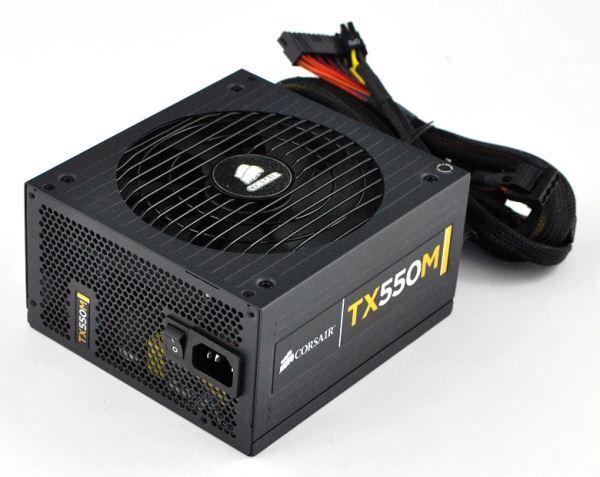Corsair TX vs. OCZ ZT 550W
by Martin Kaffei on March 26, 2012 9:30 AM EST- Posted in
- Cases/Cooling/PSUs
- Corsair
- PSUs
- OCZ
- 550W
- 80Plus Bronze
- ZT
- TX
Corsair TX550M vs. OCZ ZT550W 550W
In this review we will compare two almost identical products from OCZ and Corsair. Even so, there are still crucial differences between the offerings. With 550W both PSUs deliver more than enough power for most current systems. On the following pages we'll find out which handle overload situations the best, who has the highest efficiency, and which PSU provides the best voltage regulation.
The ZT models from OCZ are based on a Great Wall design with some modifications in the details. Interesting features include the fully modular cable management and a silent fan control. Today we will review the smallest version with 550W. Here's a complete rundown of the features.
- Available in 550W, 650W, 750W
- Single +12V rail
- Fully Modular Cabling System
- Dimensions: 150 x 86 x 175mm (W x L x H)
- 80-Plus Bronze Certified
- MTBF: 100,000 hours
- 5-year warranty
- 140mm ball-bearing fan
- Active PFC
- ATX 12V 2.2 Compliant
The second unit we test today is a Corsair TX produced by CWT. "Enthusiast Series is designed for reliable operation in high-performance PCs where clean, stable power is important." It's able to deliver the full output power at an ambient temperature of up to 50° Celsius. Like OCZ Corsair uses a double ball-bearing fan. Except the cables with mainboard connectors all cables are modular. In addition the fan grille looks unusual.
- Available in 550W, 650W, 750W, 850W
- Single +12V rail
- Modular Cabling System
- Dimensions:150 x 86 x 160mm (W x L x H)
- 80-Plus Bronze Certified
- MTBF: 100,000 hours
- 5-year warranty
- 140mm ball-bearing fan
- Active PFC
- ATX 12V 2.31 Compliant












41 Comments
View All Comments
Rookierookie - Monday, March 26, 2012 - link
>I think the days of the 550 watt psu are over unless you only do single card gaming and don't use the highest end cards.That's like saying that the days of the graphics card is over unless you play games and turn on graphic features.
Other people do exist, you know.
retrospooty - Monday, March 26, 2012 - link
" I think the days of the 550 watt psu are over unless you only do single card gaming and don't use the highest end cards."Off all gamers, PC gamers are the minority.
Of PC gamers, high end cards are the minority
Of high end cards, dual chip/SLI is the minority
You are talking about the minority, of a minority within a minority.
Of course this is a tech site and more of us here are likely to game on PC and have extreme setups and overclock to the highest possibility, but we are just a tiny fraction of the market.
bji - Monday, March 26, 2012 - link
Not to dispute your point, but this is a PC component site so non-PC gamers are not reading these articles. Therefore your first categorization is irrelevant.It is true though that high end cards are in the minority in PC gaming, and SLI a minority within the high end card market. So the fraction we're talking about is still small, just not as small within the audience of Anandtech articles as you described.
To try to stay on point: one of these power supplies comes with a feature that would prevent me from buying it, no matter what: the OCZ badge on the case.
gamoniac - Monday, March 26, 2012 - link
My OCZ Fatal1ty 550W's 4+4 pin was only 45cm, posing an issue reaching the farthest 12v ATX connector if I route it behind the motherboard (I had to get an extension). It looks like OCS has listened and increased the length to 60cm. Well done.Corsair TX seems like a good choice, but I am not sure why they need to include two FDD connectors to clutter up the case, especially if it is not a modular PSU to begin with. Does anyone still have an FDD on their PC, let alone two? I got rid of my FDD a few years ago after collecting dust in my garage for a few years.
HowQuaint - Monday, March 26, 2012 - link
Could you be more specific about the "magnetic amplifier" you specify in the OCZ unit? Wikipedia has an article about it but it doesn't seem to be a power supply technology. Since mag amps use a transformer-like device I'd guess it's a forward or flyback converter, which is more commonly used for the primary, high-voltage stage but it still works for low voltages. But saying that it "has no DC-DC converters inside" is inaccurate because any sort of secondary step-down qualifies as a DC-DC converter regardless of topology, and with cross-load numbers that low it definitely uses a secondary converter.Martin Kaffei - Monday, March 26, 2012 - link
Wikipedia is probably not the best source for information like this. As you might see there are two chokes with a black core between the 5VSB and main transformer. Those are the chokes for regulation directly behind the windings. During saturation the voltage comes through. During the (let's call it) "high impedance mode" a part of the voltage pulse gets cut.I didn't say there are no DC-to-DC converter. I know it is the most famous an easiest converter type. But in this case I'm talking about step down converter for 3.3V and 5V, who get current from 12V. Each output voltage has it's own regulation. Most common PSUs regulate 5V and 12V with the same IC which is bad for crossload regulation.
Hope this was understandable since English is just my second language.
Leyawiin - Monday, March 26, 2012 - link
The SeaSonic M12II 620 Bronze 620W is the exact same price as those two at Newegg and is a more robust and reliable power supply. I wouldn't touch one made by Great Wall or CWT when a superior SeaSonic built unit is available at that price, especially with a higher capacity.dubyadubya - Monday, March 26, 2012 - link
+1 good catch I agree 100%. That Seasonic is a way better deal, Better quality, more power for the same price its a no brainer. I'd own a CWT PSU but its a step down from a Seasonic brand or built by Seasonic PSU for sure. Personally never seen a Great wall built PSU as far as I know.johan851 - Monday, March 26, 2012 - link
Definitely. Pointing that out made me drop consideration for these - Seasonic makes a much better supply.TegiriNenashi - Monday, March 26, 2012 - link
Objective noise measurement is easy: there is free sound meter programs both for iPad and android.